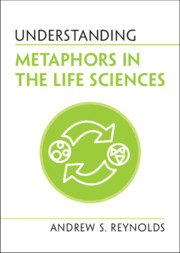‘What a timely book this is! It is precisely because biology has made such striking advances in recent years that its stock of metaphors is due for a clinical check-up. Reynolds offers a reliable and perceptive diagnosis of the framing narratives of the life sciences, sympathetically examining their strengths and weaknesses. This book should be an essential accompaniment to any study course in the biological sciences.'
Philip Ball - science writer and author of How to Grow a Human
‘In this beautifully written, highly accessible, and captivating work, Reynolds reveals the incredible extent to which scientific methods and descriptions in biology, the life sciences, and medicine are infused with metaphors. Interweaving the rich history and philosophy of the uses of these metaphors over time, their many implications for scientific reasoning, understanding, and the ethical and political dimensions of science itself are perceptively explored, with wonderful clarity and across an encyclopedic range of examples. Metaphors afford telling insight, opening doors to further inquiry and closing others. Is your genome software? Are enzymes molecular machines? Does nature select some traits over others, thereby constructing the tree of life? The fascinating world of metaphors in science comes to life on every page.'
Anjan Chakravartty - University of Miami, USA
‘I read Lakoff and Johnson's book Metaphors We Live By in the 1980s, and it was eye opening. Andrew Reynolds' book, which should be called Metaphors Science Lives By, is equally eye opening. Metaphors shape the way we live in the world. In science, they shape the way we understand the world. This can have huge implications for our lives, for better or for worse. How does this process of understanding work, especially in the life sciences? This book deals with the essential role of metaphors in this process. Written in an admirably clear style, Reynolds makes us aware of the power of metaphor, but also its dangers and pitfalls. It is an essential read for everybody interested in understanding how science and science communication work with and through metaphors. Importantly, it also dispels some common misunderstandings about the role of metaphors in science.'
Brigitte Nerlich - University of Nottingham, UK
‘Understanding Metaphors in the Life Sciences takes us from genes to cells, and up to the vast evolutionary tree of life, showing how science depends overwhelmingly on metaphor for understanding, for advance, for communication. A very important book.'
Michael Ruse - Florida State University, USA
‘Philosophically illuminating and richly informative on genetics, evolution and ecology, it should be obligatory reading for students in both the humanities and the sciences.’
Jane O'Grady
Source: Literary Review
‘Clear and concise, the book has an immense didactic value and will serve as a precious teaching aid in history and philosophy classes. However, despite being intended as an entry-level text, the book is more than a synthetic introduction to the subject. Beyond the analysis and evaluation of some of the most iconic metaphors in the life sciences, Reynolds provides a unique perspective on their function and use.’
Bartlomiej Swiatczak
Source: Metascience
'Philosophically illuminating and richly informative on genetics, evolution and ecology, it should be obligatory reading for students in both the humanities and the sciences.'
Jane O’Grady
Source: Literary Review
‘… Metaphors are ubiquitous in science, but especially so in biology, and the aim of the volume is to help us make sense of that … it offers a concise but comprehensive survey of the issue at hand. …The volume concludes with a nice succinct summary of common misunderstandings of the role of metaphors. To bring order to a rather sprawling literature, Reynolds introduces several helpful distinctions … Reynolds’s treatment of the topic offers fine help to stay alert.’
J. Arvid Ågren
Source: The Quarterly Review of Biology
‘Reynolds … achieves the unique feat of writing a book for the lay scientific-minded reader as well as the seasoned scientist. One may gain insight into how the processes of scientific ideation may turn on a word; while the other is given a duty of care to tread carefully in the act of naming things that may go on to fulfil the word’s inner semantic destiny(ies).’
Sravya Darbhamulla
Source: British Society for Literature and Science



